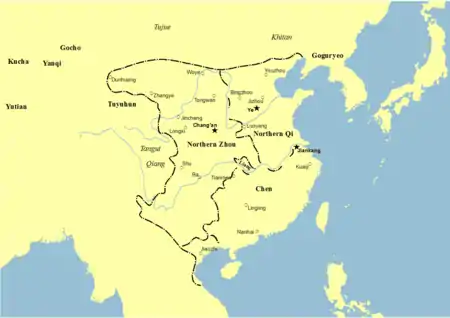Western Liang (555–587)
The Liang (555–587), known in historiography as the Western Liang (西梁) or the Later Liang (後梁) to distinguish it from the earlier Liang dynasty (502–557), was a small puppet state during the Northern and Southern dynasties period, located in the middle Yangtze region in today's central Hubei province. From 555 to 557 it was subservient to the Western Wei, from 557 to 581 to the Northern Zhou (which replaced Western Wei), and from 581 to 587 to the Sui dynasty (which replaced Northern Zhou) before the Sui annexed it.[1]
Liang 梁 | |||||||||
|---|---|---|---|---|---|---|---|---|---|
| 555–587 | |||||||||
 Western Liang and neighbors | |||||||||
| Status | Puppet state of Western Wei, Northern Zhou, and Sui dynasty Rump state of Liang dynasty (after 557) | ||||||||
| Capital | Jiangling | ||||||||
| Government | Monarchy | ||||||||
| Emperor | |||||||||
• 555–562 | Xiao Cha | ||||||||
• 562–585 | Xiao Kui | ||||||||
• 585–587 | Xiao Cong | ||||||||
| History | |||||||||
• Established | 555 | ||||||||
• Disestablished | 587 | ||||||||
| |||||||||
| Today part of | China | ||||||||
The Western Liang's founding emperor, Xiao Cha, was a grandson of the Liang dynasty founder Emperor Wu of Liang.[1] As a result, Western Liang is usually considered a rump state of the Liang dynasty after 557. From 555 to 557 the two states existed simultaneously: Xiao Cha ruled from Jiangling, while the Liang dynasty emperors Xiao Yuanming and Xiao Fangzhi ruled from Jiankang. Before 555, Emperor Yuan of Liang also ruled from Jiangling before he was captured and executed by Xiao Cha and his Western Wei backers. However, he is considered a Liang dynasty emperor rather than a Western Liang emperor because, among other things, he (at least nominally) controlled a much larger territory.
The Western Liang had 3 emperors, Xiao Cha (Emperor Xuan), Xiao Kui (Emperor Ming), and Xiao Cong (Emperor Jing). From 617 to 621, when the Sui dynasty collapsed, Xiao Cha's great-grandson Xiao Xian occupied the former Western Liang territory (and more) and proclaimed himself King of Liang, but his short-lived state is usually considered separate.[1]
Emperors
| Temple Names ( Miao Hao 廟號 miào hào) | Posthumous Names ( Shi Hao 諡號 ) | Personal Names | Period of Reigns | Era Names (Nián Hào 年號) and their relevant range of years |
|---|---|---|---|---|
| Convention: Xi Liang + posthumous name | ||||
| Note: some historians consider Western Liang as a continuation of the Liang dynasty since it was founded by Xiao Cha (Emperor Xuan), a grandson of Xiao Yan (Emperor Wu), the founder of the Liang dynasty. | ||||
| Zhong Zong (中宗 zhōng zōng) | Xuan Di | 蕭詧 xiāo chá | 555-562 | Dading (大定 dà dìng) 555–562 |
| Shi Zong (世宗 shì zōng) | Xiao Ming Di | 蕭巋 xiāo kuī | 562-585 | Tianbao (天保 tiān bǎo) 562–585 |
| Did not exist | Xiao Jing Di | 蕭琮 xiāo cóng | 585-587 | Guangyun (廣運 guǎng yùn) 585–587 |
References
- Dillon, Michael (2016). Encyclopedia of Chinese History. London: Taylor & Francis. p. 387. ISBN 9781317817161. Retrieved 10 September 2019.